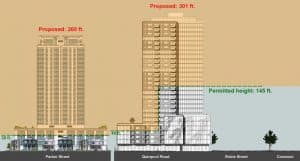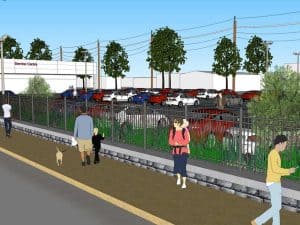If it’s become acceptable — routine really — for developers to apply to bend municipal planning strategy and land use zoning regulations to green-light projects that don’t fit within the rules as they are, should it not be just as possible for ordinary citizens to seek similar exceptions to red-light those who plan to do things zoning laws legally permit but which are not in the public interest?
Let’s consider two cases.

The Willow Tree block
First, there’s the Robie-Quinpool-Parker block adjacent to the Willow Tree.
It’s currently home to a 10-storey office building and four-storey above-ground parking garage, a former funeral home and single family housing, all of which comply with existing land use bylaws.
Those properties are now owned by two major developers. They want city council to rewrite the rules so they can erect two massive high-rise towers on the site.
Their plans not only fly in the face of neighbourhood height restrictions — one would be twice as tall as existing rules allow— but they also don’t comply with unit and population density regulations. Not to forget that local residents oppose them.
No matter.
There’s a process that lets developers apply to city council to make exceptions to the rules whenever they feel the need.
There’s no similar process for citizens.

Steele Honda’s paradise paved.
Which brings us to Steele Honda, the car dealership that plans to bulldoze two dozen north-end residential properties around its Robie Street lot in order to make space for… more car parking and vehicle display-casing.
Really? Does replacing housing for people with parking for cars — especially on prime peninsular residential real estate — fit the city’s long-term municipal planning strategy? Is it in the public interest?
Most of us would probably say no, but the area is zoned commercial — based on and use bylaws passed nearly 40 years ago — so Steele has the right to do what it does. And the rest of us have no recourse.
I’m not advocating for councillors to rule individually on “every garage and façade change.” That would be, as Councillor Waye Mason rightly points out, “chaos. No one would know what they could ever build.”
But it’s at least worth noting the power imbalance that exists between developers, who largely finance most councillors’ election campaigns, and the rest of us who merely vote.



 STEPHEN KIMBER, a Professor of Journalism at the University of King's College in Halifax and co-founder of its MFA in Creative Nonfiction Program, is an award-winning writer, editor and broadcaster. He is the author of two novels and eight non-fiction books. Buy his books
STEPHEN KIMBER, a Professor of Journalism at the University of King's College in Halifax and co-founder of its MFA in Creative Nonfiction Program, is an award-winning writer, editor and broadcaster. He is the author of two novels and eight non-fiction books. Buy his books
This article shows Kimber’s lack of knowledge of the planning world. Plans (once adopted) are out of date – that’s the reality. The plan amendment process is there so that planners don’t review an application on the basis of rules/policies established in the 1970’s (which the quinpool policies are based on). Should we be reviewing the application in that context or the context of today? I’d argue today.
The fact is communities change – unfortunately; plans don’t keep up with that change. Plans and rules are not real time; it takes time for change to occur and rules to catch up. Plan amendments allow for site specific changes so that if the plan/rules haven’t caught up – then a proposal can be reviewed on it’s merits in the context of planning of now. Not then – which would have been pushing a car oriented, high parking idea. The other flaw in the Quinpool policies is that they were written with a very specific intent – stop any major development in the area. If we are going to grow the City; we can’t keep policies like that intact. All areas must be allowed to grow. But how that growth occurs, involves public comments and input – hence why plan amendments have an engagement process and a public hearing and the decision is made by Council.
In terms of the Car lot – property rights are established in zoning. Unfortunately; if the zoning allows the property owner to do something it is very difficult to simply take it away because of public outcry. The upside to this issue (and I don’t like the expansion at all), is that it raises the issue to be dealt with in the new Centre Plan. Personally, I don’t think there should be any car dealerships on the Peninsula at all – unless they are part of a high density mixed use project like some dealerships in NYC or Toronto (not the expansive lot we see today). With the Centre Plan, we have the chance to change the policies/zoning so restrict new dealerships from occurring. It won’t push them out though – because legally they can stay. But if new rules are put in place – they can’t expand. If the area is deemed a growth area – the land value increase should push them out soon enough. The upside is that when they do leave, it will be a large prime parcel to develop.
In terms of communities wanting to seek change to zoning rules; they actually DO have a mechanism to seek that change. It’s called your community Councillor. Speak to them – raise the issue and make the case. They can direct staff to do something through a notice of motion.
Please read my note below. An MPS amendment was brought to the community and the deal essentially agreed to was a larger greenbelt for increased density above MPS allowance. That should have been the end of the story, but no. Read the staff report attached within my note.
There are many, many examples where community input has been opposed to the an MPS amendment yet Council supports the developer the vast majority of times.
In an ideal world you would be correct. However Halifax development is not an ideal world, unless you are a developer.
Mr Kimber, dig deeper. There is also a city driven “cash in lieu” program that allows developers to increase density by decreasing community greenspace in exchange for providing the city a pocket full of coin. The community of Eastern Passage accepted MPS amendments to the developers benefit in exchange for a larger parkspace on Erindale Estates. Not long after that city staff, through the UARB, transferred a large portion of that land to Bedford’s Marsh Lake park lands (a value of $1.62 million) in order to keep a separate ARMCO vs City of Halifax case from going to court. Benefactors are the City, ARMCO and Bedford, while the community of Eastern Passage wonders what in hell just happened to their parkland. Reference is here: http://www.halifax.ca/…/agen…/documents/150804ca1114.pdf
Halifax reminds me of a beautiful woman who keeps trying to look generic, getting a nip and a tuck and a lop and a gouge until she no longer has any unique identifying features left. She has no idea what others see in her, so she works very hard to mimic newer cities – taller buildings, more glass, less of that dusty history stuff and more shiny urban stuff. She’s in process of ruining herself and we are witness to it. Where are the preservation laws? Where are the taste police?